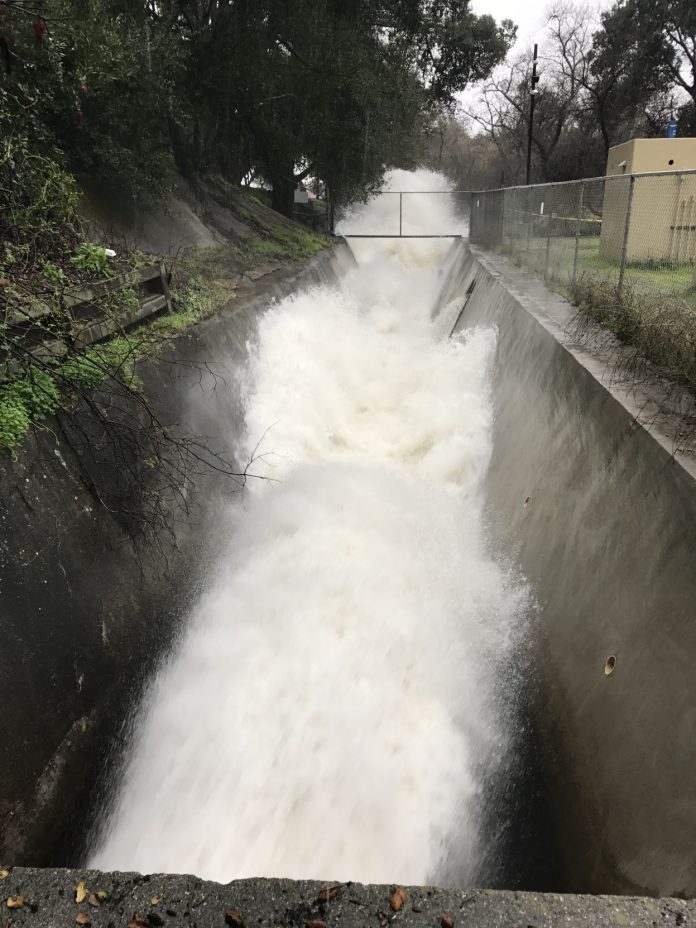
More extensive design plans for Anderson Dam’s earthquake retrofitting project have doubled the overall cost and pushed the start date to 2020, according to Santa Clara Valley Water District staff’s Dec. 9 presentation to its board.
The project, which will take between three to four years to complete with a target of year 2024, is now expected to cost an estimated $400 million, up from the initial $200 million figure back in 2013. The project is being funded primarily through the district’s water rates, along with $60 million from the Measure B parcel tax.
SCVWD staff told its board of directors last month that the change order comes “as a result of geotechnical investigations completed in spring 2016 and associated dam failure analyses (that require) a more extensive retrofit of the dam embankments.”
Water district staff are scheduled to give a similar presentation at the Jan. 18 City of Morgan Hill council meeting and then hold at least one community meeting in early February. The next phase, which will take at least another year, is to complete an Environmental Impact Report.
“We basically have to dismantle nearly the entire dam and then rebuild it with the right materials and the right compaction,” said Katherine Oven, a deputy operating officer with the water district.
While the original 2013 project plans maintained some existing rockfill and buttress on each the upstream and downstream sides of the dam, further testing resulted in a design change to remove all the old material and replace it with new gravel fill throughout each side to fortify it.
Additionally, the modified plans call for the removal of a ground layer material known as alluvium below the new gravel fill because it is prone to liquefaction, according to Oven. Alluvium is defined as a deposit of clay, silt, sand and gravel left by flowing streams.
“It’s material that isn’t rock solid so when triggered to move by an earthquake could turn into a jello consistency and everything above it is prone to impact,” Oven said.
In the 2013 plans, $43 million was dedicated to the upstream/downstream embankments. However, the 2016 modified project pours $187 million into those same embankments.
Other cost increases in the modified version are: $108 million to $136 million for the intake high and low level outlets; $43 million to $70 million for planning/design and $5.7 million to $7.5 million for spillway/crest raise.
“Since we’re dismantling most of the dam and rebuilding it, we don’t foresee a need for any other extensive work,” said Oven of future cost increases. “We’re peeling back the onion almost to the core and reconfiguring it….so staff is pretty confident that costs put forth right now are pretty firm.”
Workers drilled a number of borings through the existing dam embankment and then evaluated the soil samples to determine the proper renovation strategy. That process “has taken up most of our time in the last three years,” Oven said.
All reports have been sent to the state’s Division of Dams and Safety and the Federal Energy Regulatory Commission for review as well as to a board of consultants comprised of experts in the field.
In addition to the dam retrofit, the project also entails a new outlet tunnel and beefing up the spillway (an emergency chute out of the reservoir), among other improvements.
“This is a major undertaking,” Oven said. “We’re not out of the woods until we’re out of the woods. There could be some setbacks during construction, but we’re trying to eliminate as many unknowns now in the planning phase so it’s smooth sailing later on.”
Hed: What to do with all that water
Along with the Anderson retrofit, SCVWD is also working on two other smaller-scaled seismic retrofit projects at Calero and Guadalupe dams.
Anderson, the district’s largest reservoir that provides about 25 percent of water that the entire county consumes each year, is currently at 61.4 percent of capacity, or 55,49.7 acre feet of a possible 90,373, according to Jan. 17 readings on valleywater.org. An acre foot covers an acre of land 1 foot deep—enough water to supply two families of five for a year.
Because of seismic restrictions imposed by state regulators, the lake can only be filled to about two-thirds of its maximum capacity.
During the multi-month dewatering phase, where Anderson will be drained, water officials plan to pump as much water as possible through to the county’s water treatment plants and release additional water to recharge the local groundwater basin.
“As we dewater the facility, we are going to try to put as much of the water as we can to beneficial use,” Oven said.
The original project was scheduled to begin Spring 2017 with an estimated completion date between November and December 2020. The modified plan has construction beginning in 2020 and running through 2024.







